TOTAL LUXURY, TOP NOTCH, 14 DAY GUIDED & FLY-IN NAMIBIA SAFARI
– 2017 –
With a percentage of the cost of this itinerary going to The Cheetah Conservation Fund to help continue their work*

This Namibia Safari affords you the chance to explore all of its wildlife and to experience this magnificent and memorable country in a very personal way.
You will have your own professional and experienced safari guide who will enhance your enjoyment of this unique country by making it a fascinating and stress-free journey of discovery amidst incredibly dramatic scenery. The knowledge, experience, and character of our guides are critical to a successful safari which is why we ensure that they are both personable and very professional. Your Safari guide will have an intimate knowledge of each area and camp/lodge that you visit, allowing them to share the local insights and highlights whilst adding continuity and depth to your safari. The presence and company of your TLC World guide will turn your ‘True African Safari’ into an experience of a lifetime!
Windhoek – Otjiwarongo (Cheetah Conservation Fund) – Etosha (Onguma Game Reserve, Ongava Game Reserve, Desert Rhino Camp) – Damaraland – Sossusvlei, NamibRand Nature Reserve – Windhoek

 N.B. This itinerary is a guide only. You can add time and places to this and upgrade, reduce, or change travel and accommodation with us to make this a truly personal journey. Just click ‘enquire’, or simply phone us.
N.B. This itinerary is a guide only. You can add time and places to this and upgrade, reduce, or change travel and accommodation with us to make this a truly personal journey. Just click ‘enquire’, or simply phone us.
PHONE: 01202 030443 or click ‘enquire’
Namibia is a vast country, even by African standards, covering an area approximately twice the size of California and four times the size of the United Kingdom, but with a population of a mere 2 million. This gives one of the lowest population densities in the world. It is also an ‘ageless land’; visible through a heritage of rock art created by stone-age artists and geological attractions such as the petrified forest where fossilised tree trunks have lain for over 280 million years. When added to the space and silence, these factors all contribute to a feeling of antiquity, solitude and wilderness.

The climate is typical of a semi-desert country. Days are warm to hot and nights are generally cool. Temperatures are modified by the high plateau in the interior and by the cold Benguela Current that runs along the Atlantic coastline. Except for the first few months of the year, the country is generally dry with very little rain.
________________________________________
TRIP HIGHLIGHTS
• Travel with one of Namibia’s most reputable and well-known naturalist guides.
• Visit the renowned Cheetah Conservation Fund and learn more about their conservation initiatives.
• Enjoy guided game drives within the Etosha National Park, from the vantage point of a specially modified, air conditioned 4×4 with pop tops.
• Memorable and exciting game drives on both the Ongava and Onguma Private Game Reserves.
• Explore the Damaraland region and search for desert adapted elephant and other desert adapted wildlife in the local ephemeral river systems.
• Fly along the Diamond Coast viewing shipwrecks, abandoned diamond camps and the giant sand dunes.
• Visit southern Africa’s largest private nature reserve, the NamibRand Nature Reserve.
• Spend an evening with an astronomer learning all about the southern hemisphere’s night sky
________________________________________
ITINERARY IN BRIEF
Day 1 Arrival in Windhoek, The Olive Exclusive All-Suite Hotel
Day 2 & 3 Road transfer to Babson House, Cheetah Conservation Fund
Day 4, 5 & 6 Onguma – The Fort, Onguma Game Reserve, eastern boundary of Etosha National Park
Day 7 & 8 Ongava Lodge, Ongava Game Reserve, southern boundary of Etosha National Park
Day 9 & 10 Desert Rhino Camp, Palmwag Concession
Day 11 Mowani Mountain Camp, Damaraland
Day 12 & 13 Sossusvlei Desert Lodge, NamibRand Nature Reserve
Day 14 Departure from Windhoek International Airport
________________________________________
DETAILED ITINERARY
Day 1 Arrival in Windhoek
After landing at Windhoek’s International Hosea Kutako Airport, about 40km outside of Windhoek, you will be welcomed by a TLC World representative who will transfer you to The Olive Exclusive, where you will stay in their beautifully designed rooms for your first night in Namibia. Take the rest of the day is there for you to relax and acclimatize, with the option to go explore Windhoek city shops and craft market on your own if desired. Dinner this evening will be for your own account, to give you the freedom to either dine at your hotel, or out at one of the popular restaurants in town if preferred.
Windhoek Capital City: Windhoek, Namibia’s capital nestles among rolling hills, bounded by the Eros Mountains in the east, the Auas Mountains to the south and the Khomas Hochland in the west. It is a meeting place between Africa and Europe, the modern and the old. In the capital’s main street, well-preserved German colonial buildings are in sharp contrast with modern architectural styles, while Herero women in their traditional Victorian dresses mingle with executives dressed in the latest fashions.
Located centrally, Windhoek is the starting point of an adventures holiday for many visitors to the country and an ideal base from where to explore the rest of the country. The city’s restaurants offer a variety of meals, ranging from international and continental cuisine to German dishes such as Eisbein with Sauerkraut and African delicacies such as mopane worms. Windhoek offers a wide choice of accommodation options, ranging from four-star hotels and homely pensions to backpackers establishments and campsites. In the rural areas beyond the city’s limits there are also a number of lodges and guest farms.
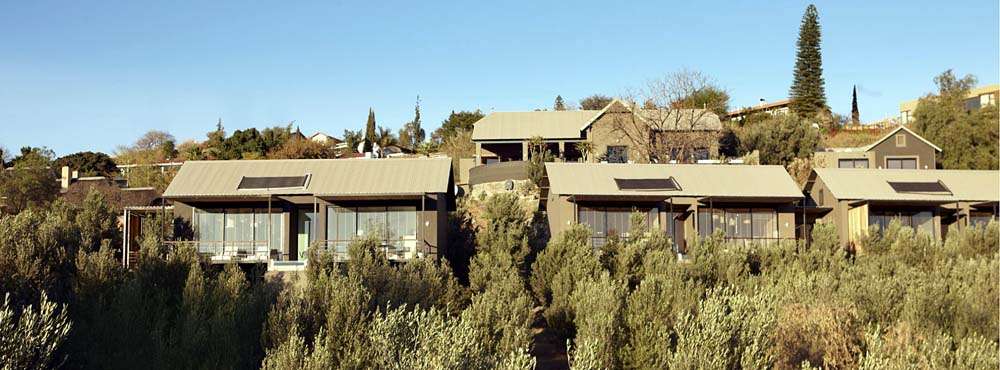
The Olive Exclusive All-Suite Hotel: Olive Exclusive is a lovely welcoming hotel situated close to Windhoek’s city centre in the quiet, peaceful suburb of Eros. Nestled amongst an olive tree plantation, this new, luxurious hotel provides exclusive suite accommodation with beautiful views over the olive trees towards the Windhoek Mountains. Accommodation is offered in premier suites or junior suites. All guests have access to a sparkling communal pool located amongst the olive grove. All suites have their own lounge area and dining room, giving guests the option of enjoying meals in their own room, or of joining the other guests for meals at the main restaurant. The en-suite rooms offer all the added luxuries of satellite TV, iPod music system, fully-stocked mini-bar, premier wine selection, direct-dial telephone, air conditioner, hair-dryer, wall mounted safe, personal computer for internet access, complimentary wireless internet access, goose-down duvets, 100% cotton linen and style in abundance. Enjoy a drink on the extensive outdoor patio or in the Himba lounge before settling in to the innovatively furnished dining room which offers a first class dining experience to guests. The overall feel is one of indulgent luxury, while still retaining a feel of simplicity and elegance.
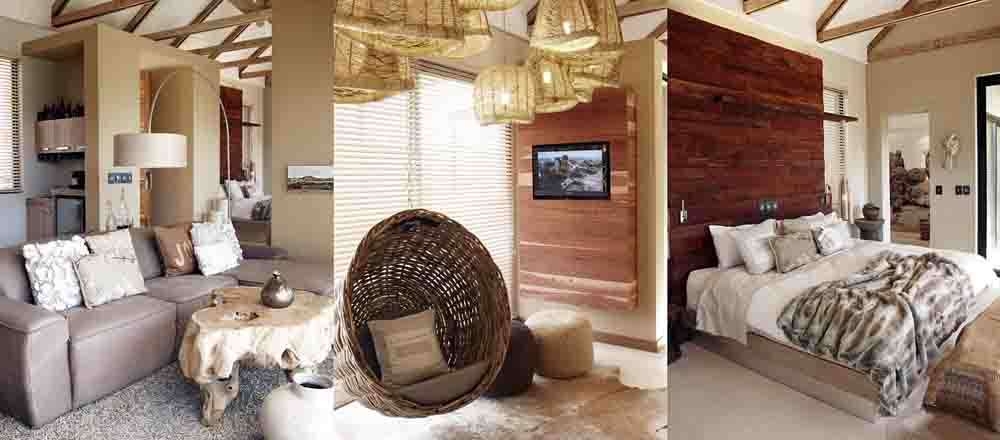
Overnight: The Olive Exclusive (Premier Suite) Bed & Breakfast Basis
________________________________________
Day 2 & 3 Windhoek to Babson House, Cheetah Conservation Fund
 After breakfast at The Olive Exclusive this morning you will be collected by a TLC World representative. You then set off on your journey, which today takes you north through Namibia’s central highlands and commercial farmlands to reach Babson House at the Cheetah Conservation Fund (CCF).
After breakfast at The Olive Exclusive this morning you will be collected by a TLC World representative. You then set off on your journey, which today takes you north through Namibia’s central highlands and commercial farmlands to reach Babson House at the Cheetah Conservation Fund (CCF).
The next two nights will be spent here as arranged by TLC World in conjunction with the Cheetah Conservation Fund.
Here’s a real opportunity to get ‘up close and personal’ with Cheetahs and to really start to understand about their behavior.
You’ll arrive at CCF mid/late afternoon and either freshen up and relax, or take a sundowner at the reserve before dinner.

The 2nd day is then a full day of activities, starting with the Cheetah Run at 8am and concluding with a meeting with the CCF ambassador cheetahs in late afternoon. See what your programme includes.
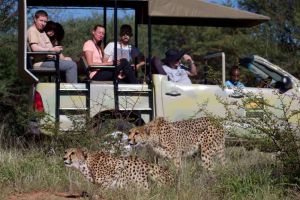 08:00 Cheetah run. You’ll experience the thrill of seeing cheetahs running close up when you join them for their morning exercise as they “hunt” a specially made lure. Capture the amazing speed of the cheetah up close with your own photos and video.
08:00 Cheetah run. You’ll experience the thrill of seeing cheetahs running close up when you join them for their morning exercise as they “hunt” a specially made lure. Capture the amazing speed of the cheetah up close with your own photos and video.
08:45 Coffee or tea & muffins at the cafe
09:30 Behind the scenes Cheetah Experience: caring for CCF’s orphan cheetahs with a member of the CCF cheetah team on their morning duties to help feed and care for the resident cheetahs; including those not generally accessible to the public as they are being prepared for release back in to the wild
 12:00 Visitor Centre tour including livestock guarding dog project and model farm
12:00 Visitor Centre tour including livestock guarding dog project and model farm
13:00 Lunch at the café
14:00 Centre Feeding. An ideal opportunity to study cheetah behavior and pecking order.
14:30 Lab and Clinic tour.
15:00 Cheetah Drive. A guided drive into one of CCF’s expansive enclosures to meet some of their female Cheetahs – a great opportunity for photographs.
16:00 Meet the ‘Ambassador cheetahs’
You’ll learn about the exceptional work that CCF conducts in the protection of Namibia’s Cheetah population including the re-wilding programme and farmer stock protection projects.
Without the valuable work of CCF and other like-minded initiatives the Cheetah population in Namibia would be under much greater threat
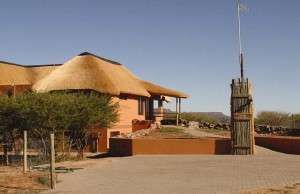
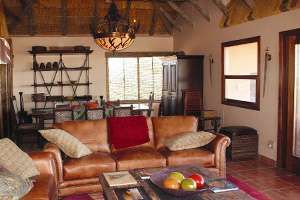
Overnight: Babson House Full Board & Activities
________________________________________
Day 4 Cheetah Conservation Fund to Onguma Game Reserve
This morning you will be collected from the CCF by your personal TLC World guide who will be accompanying you for the greater part of your safari. After freshening up you take to the road, heading north to make your way towards the Etosha National Park and the luxurious Onguma – The Fort, nestled inside the private Onguma Game Reserve. This afternoon your guide can take you into the park on your first game drive if desired, or you can just relax and enjoy your tranquil surroundings whilst observing the game that comes to the nearby waterhole to drink.

Onguma – The Fort: Positioned to give guests unrivalled views of the spectacular Namibian sunset, Onguma – The Fort is a unique refuge in this vast landscape. Overlooking the beautiful scarceness of the Etosha Pans, the Fort gently enfolds guests within massive, cool raw walls and uncompromised luxury. Each suite offers sprawling views of Etosha and Fisher’s Pan, and has a spacious bathroom with both an indoor- and a private outdoor shower. From every corner of your suite, wooden decks and sun-loungers invite you to come out and play. Elaborate antique African doors, raw plastered walls and elegant furnishing fuse classic African style with a touch Moroccan and Indian themes – creating a world of dreams. At Onguma – The Fort, the diverse wildlife can be enjoyed from the comfort of your suite, on a sunset game drive or from the main tower – offering unparalleled views of this unique landscape. Zebra, giraffe, lion, a variety of antelope and superb birdlife will accompany you during your stay. Savour relaxing sunset moments in the outdoor pool, as the view invites you to become one with the dream.

Overnight: Onguma – The Fort Full Board & Excursions with your Guide
________________________________________
Day 5 & 6 Etosha National Park / Onguma Game Reserve

The next two days are dedicated to memorable game drives within the eastern section of Etosha National Park with your guide, either exploring the area around Namutoni, or you can head north past Fischer’s Pan and up into the Andoni Plains if preferred. You return to camp for lunch and an early afternoon rest, spending your afternoons on a game drives on the private Onguma Game Reserve, culminating with sundowners overlooking Fischer’s Pan. You then return after sunset with enough time to freshen up before dinner and an evening overlooking the camp’s floodlit waterhole.

Onguma Game Reserve: Situated on the eastern side of Etosha National Park and bordering Fisher’s Pan, Onguma Game Reserve has more than 20,000ha of protected land and wildlife. The nature reserve boasts over thirty different animal species consisting of plains game such as kudu, giraffe, eland, oryx, hartebeest, zebra, impala and many more roam freely, as well as predators such as lion, cheetah and leopard, being common residents of the area. Onguma Game Reserve is now proud to be home to a family of black rhinos! More than 300 bird species can also be viewed at Onguma Game Reserve.
Overnight: Onguma – The Fort Full Board, Etosha Drives with your Guide & PM Onguma Drives
________________________________________
Day 7 Eastern to southern boundary of Etosha National Park
Full day dedicated to memorable game-viewing inside the Etosha National Park from the comfort of your private safari vehicle with your guide. You enter the park through the eastern Von Lindequist Gate and game drive your way west through the breadth of the Park, stopping at selected waterholes to observe the game gathered there along the way. You then exit the park through the southern Andersson Gate to make your way through the private Ongava Reserve to reach Ongava Lodge just as it is getting dark.
Etosha National Park: Etosha National Park covers 22,270km², of which approximately 5,000km² is made up of saline depressions or ‘pans’. The largest of these pans, the Etosha Pan, can be classified as a saline desert in its own right. The Etosha Pan lies in the Owambo Basin, on the north-western edge of the Namibian Kalahari Desert. Until three million years ago it formed part of huge, shallow lake that was reduced to a complex of salt pans when the major river that fed it, the Kunene, changed course and began to flow to the Atlantic instead. If the lake existed today, it would be the third largest in the world.
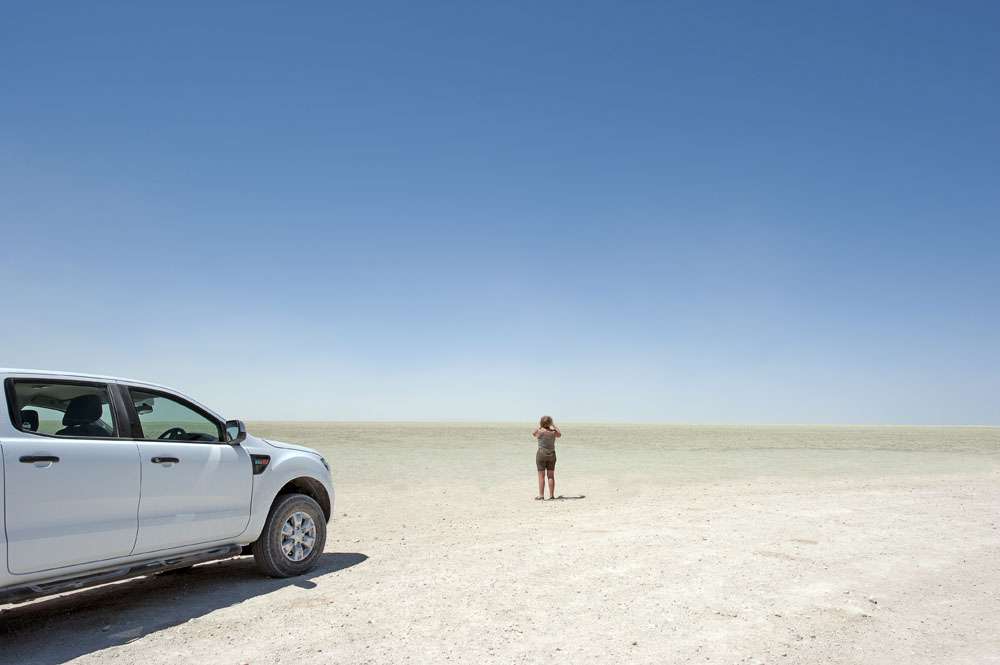
Etosha is the largest of the pans at 4,760km² in extent. It is nowadays filled with water only when sufficient rain falls to the north in Angola, inducing floods to flow southward along the Cuvelai drainage system. The Park consists of grassland, woodland and savannah. Game-viewing centers around the numerous springs and waterholes where several different species can often be seen at one time. The Park boasts some 114 mammal and over 340 bird species. Wildlife that one might see includes elephant, lion, giraffe, blue wildebeest, eland, kudu, gemsbok (oryx), zebra, rhino, cheetah, leopard, hyena, honey badger and warthog, as well as the endemic black faced impala.
Ongava Lodge: Ongava Lodge is situated on the slopes of a rocky outcrop within the private 30,000ha Ongava Game Reserve, which shares a common border with Etosha. Ongava Lodge offers guests the full Etosha experience whilst providing superb accommodation and service, as well as night drives and nature walks on the reserve. At Ongava Lodge guests are accommodated in luxury air-conditioned thatched chalets with private veranda, all with en-suite bathroom. The main lounge, dining and pool area is situated on the foothills of the Ondundozonanandana Range, overlooking a floodlit waterhole and a vast plain.
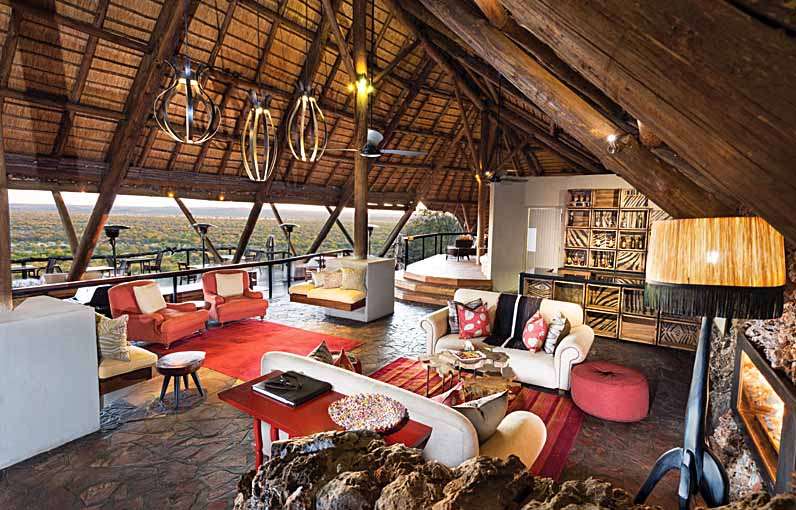
Overnight: Ongava Lodge Full Board & Excursions with your Guide
________________________________________
Day 8 Etosha National Park / Ongava Game Reserve
Today you will be treated an exciting morning game drive into the southern and central areas of Etosha National Park with your guide, and this afternoon you have the option to head out on a fascinating game drive within the private Ongava Game Reserve. This evening you can relax on the main deck or by your room to observe the wildlife coming to the camp’s nearby floodlit waterhole to drink. Alternatively you might like to spend a full day inside Etosha on leisurely game drives with your guide, heading east across the park to spend time in the area around Halali.

Ongava Game Reserve: The private Ongava Game Reserve features almost all of the characteristic wildlife of the area, with plains game such as springbok, gemsbok, wildebeest, Burchell’s zebra, Hartmann’s mountain zebra, waterbuck, red hartebeest, giraffe, eland and endemic black-faced impala seen, while Etosha itself has elephant to add to the list. In Etosha, large herds of plains game concentrate around the waterholes in the dry season, making for exciting wildlife viewing. Lion move between the Park and the Reserve and both black and white rhino can be seen. 10 of Namibia’s 14 endemic bird species have been recorded in the 340 species on Ongava.
Overnight: Ongava Lodge Full Board, Etosha Drives with your Guide & PM Ongava Drive
________________________________________
Day 9 Etosha National Park to Palmwag Concession , Damaraland
Today’s journey takes you into the wonderful and diverse region of Damaraland, travelling via the scenic Grootberg Pass and into the rugged and largely untouched Palmwag Concession to reach Desert Rhino Camp. The drive through the reserve to reach the camp also acts as a nature drive to give you a taste of this exceptional area and the many different (and some endemic) species of flora and fauna that can be found here. If time allows, you will have the option to head out on an exciting scenic nature drive this afternoon.
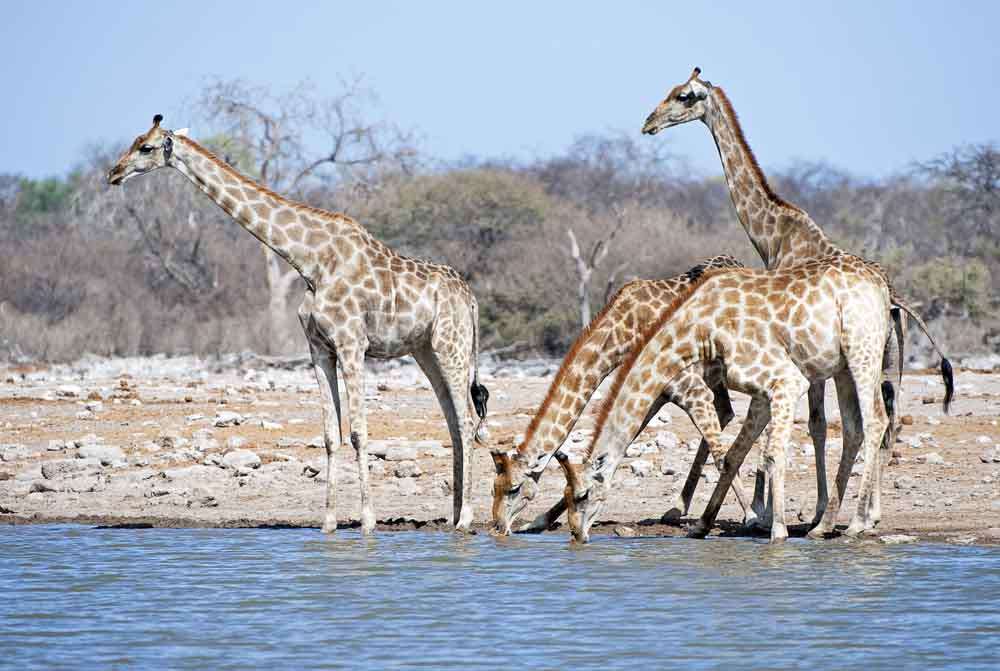
Desert Rhino Camp: Desert Rhino Camp is a comfortable and charming tented camp located on the unique Palmwag concession in rugged northern Damaraland. This camp offers a fascinating insight into the ecology and conservation of the area, as well the incredible desert adapted black rhino. Desert Rhino Camp lies amongst rolling, rocky hills with scattered euphorbia, ancient Welwitschia plants, scrubby vegetation and isolated clumps of trees of the 450,000ha Palmwag Concession. This region is marked for its tranquil, minimalist beauty, surprising wealth of arid-adapted wildlife and the largest free roaming black rhino population in Africa.
Set in a wide valley sometimes flush with grass, accommodation at Desert Rhino Camp is in Meru-style canvas tents, raised from the ground on a wooden deck. Each tent features an en-suite bathroom with a hand basin, flush toilet and shower. Beds are made up with crisp, white linen and have two dark wood bedside tables with wicker reading lamps. An extension of the deck functions as a front verandah where guests can relax in director’s chairs to take in the magnificent vistas of the surrounding desert and Etendeka Mountains.
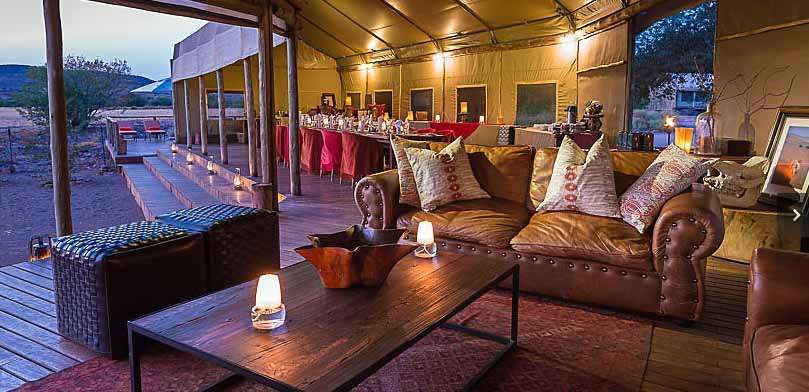
The tented restaurant and lounge area of Desert Rhino Camp is also raised on a wooden deck in a single tent which is open plan and has partially open sides offering panoramic views. To one side there are couches and to the other a large, simple dining table. Evening meals are taken around the fire pit, in front of the lapa, where guests can relax and socialize. Activities during your stay here include guided 4×4 scenic drives, rhino tracking, walks, birding and nature drives.
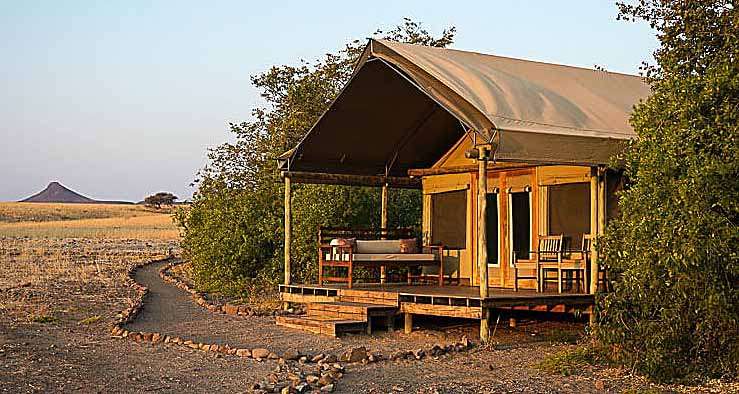
Desert Rhino Camp functions as a collaborative effort between Wilderness Safaris and the Save the Rhino Trust (SRT) – an NGO that has been has been instrumental in the preservation of these rare, desert adapted black rhino. Having barely survived the slaughter of ’80s and ’90s throughout other parts of Africa, the black rhino population has doubled since the formation of the SRT.
Overnight: Desert Rhino Camp Fully Inclusive (all meals, scheduled lodge activities & local drinks)
________________________________________
Day 10 Desert Rhino Camp, Palmwag Concession
A full day of guided excursions within the expansive Palmwag Concession as arranged by Desert Rhino Camp. You will spend an exciting and memorable morning out rhino tracking with the assistance of staff from Save The Rhino Trust (SRT), followed by a picnic lunch before returning to camp in the early afternoon. Afterwards, you can relax at camp until you head out again later in the afternoon for a scenic nature drive or walk. Wildlife in the area includes Hartmann’s mountain zebra, giraffe, desert adapted elephant, ostrich, lion, oryx, spotted and brown hyena, cheetah, kudu, leopard, and in particular this area is home to one of the world’s largest natural populations of the rare black rhino.
Palmwag Concession: The Palmwag Concession spans 4,500km² of arid wilderness transected by Ephemeral River courses which, along with the occasional natural spring, provide an oasis to the wildlife that have adapted to this harsh environment. The rugged mountains and canyons provide a last refuge for some of the continent’s most unique wildlife such as the legendary desert elephant, lion and the last free-roaming black rhino population on earth. In fact seventy-five per cent of Namibia’s endemic species inhabit this last bastion of the wilderness.

Desert Black Rhinoceros: Namibia is home to the larger of two subspecies of the black rhinoceros found in southern Africa. The only population that remains in the wild, unfenced and outside reserves occupies an arid range in the western Kaokoveld. Their preferred habitat is the mountainous escarpment, but they follow ephemeral rivers into the northern Namib as well, especially when conditions are favourable after rains. They are the only black rhinoceros in Africa that are internationally recognized as a “desert group”. Like desert-adapted elephant, they cover great distances. They walk and feed at night and rest during the day.
To meet their nutritional and bulk requirements they browse on no fewer than 74 of the 103 plant species that grow in their range. One of the few animals to eat fibrous Welwitschia leaves; they even feed heavily on the milkbush (Euphorbia virosa) with its sharp spines and toxic latex, presumably because of the high water and fat content. They are physical defenses of dryland plants without apparent harm. Once widespread in the subcontinent, black rhinoceros are an endangered species. The smaller subspecies, Diceros bicornis minor, does not range into Namibia.
Overnight: Desert Rhino Camp Fully Inclusive (all meals, scheduled lodge activities & local drinks)
________________________________________
Day 11 Desert Rhino Camp to Mowani Mountain Camp
The road today takes your back through the Palmwag Concession and on to Mowani Mountain Camp. Along the way your guide will take you on an exciting 4×4 excursion through the ephemeral river valleys to explore this remarkable region and to search for game, including the elusive desert adapted elephants if they are in the area. Damaraland is home to a variety of desert adapted wildlife and hidden desert treasures. You will normally return to camp for lunch and go out again in the afternoon. You also have the option to take a walk with your guide into the local area around camp, or relax and enjoy some well-deserved leisure time.

Desert Adapted Elephant: In habitats with sufficient vegetation and water an adult elephant consumes as much as 300kg of roughage and 230 litres of water every day of its life. Consider what a herd of them would eat and drink in a week or a month or a year. Finding an African elephant in a desert? Well, yes and not only elephant, but other large mammals as well, such as black rhinoceros and giraffe. Their ranges extend from river catchments in northern Kaokoveld as far south as the northern Namib. Apart from the Kunene River, seven river courses northwards from the Ugab provide them with possible routes across the desert, right to the Skeleton Coast.
The biggest are the Hoarusib, the Hoanib, the Huab and the Ugab Rivers. Desert adapted elephant in Kaokoland and the Namib walk further for water and fodder than any other elephant in Africa. The distances between waterholes and feeding grounds can be as great as 68 km. The typical home range of a family herd is larger than 2,000km², or eight times as big as ranges in central Africa where rainfall is much higher. They walk and feed at night and rest during the day. To meet their nutritional and bulk requirements they browse on no fewer than 74 of the 103 plant species that grow in their range. Not a separate species or even a subspecies, they are an ecotype unique to Namibia in Africa south of the equator, behaviourally adapted to hyper-arid conditions. Elephant in Mali on the southwestern fringe of the Sahara Desert are the only others known to survive in similar conditions.
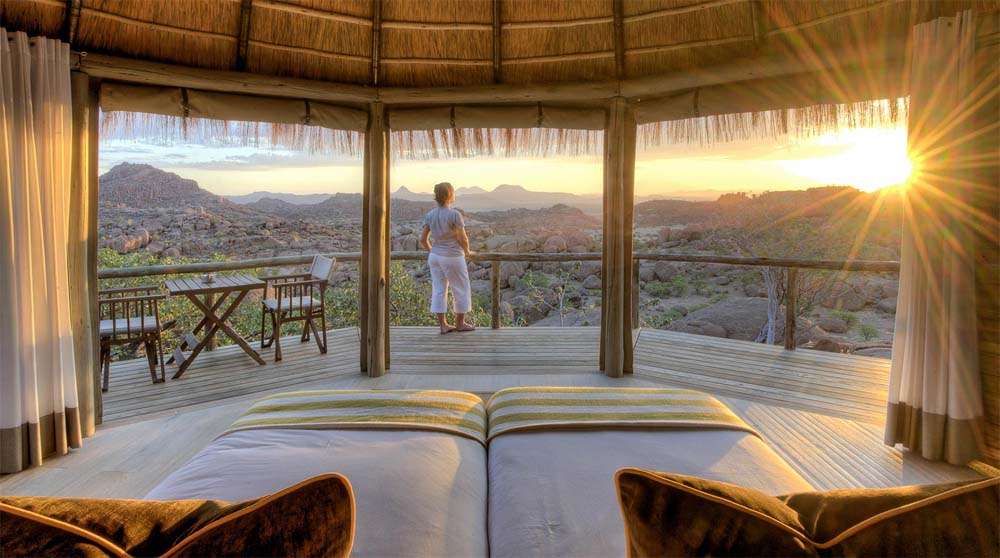
Mowani Mountain Camp: Mowani Mountain Camp is ideally located a short drive from the local attractions in the Damaraland area. The Camp is nestled amongst giant granite boulders, overlooking the ephemeral Aba Huab riverbed where desert adapted elephants often traverse. The thatch dome-shape structures echo the shape of the rough textured granite boulders amongst which they are built, a theme complemented by African wood carvings and artifacts. Mowani’s main complex consists of a reception area, bar, spacious alfresco dining room and lounge overlooking a waterhole with an inviting fireplace nearby to relax beside in the evenings. A refreshing swimming pool and fantastic sundowner viewpoint with its own bar also complement the Camp. Guests are accommodated in luxury East African style en-suite safari tents built on raised wooden platforms, each with a private verandah and splendid views over the Aba Huab valley.
Overnight: Mowani Mountain Camp Full Board & Excursions with your Guide
________________________________________
Day 12 Damaraland to NamibRand Nature Reserve
Today your guide will transfer you to the nearby Twyfelfontein Airstrip to meet up with your pilot. After bidding farewell to your guide, you board your scheduled light aircraft for your flight to the NamibRand Nature Reserve. Your flight first takes you southwest to Swakopmund to refuel, then continuing south along the coastline (fog permitting) over Walvis Bay lagoon, the salt pans, Sandwich Harbour and shipwrecks, before heading inland over abandoned diamond mining camps and Sossusvlei, with an amazing bird’s eye view of the great dune sea that stretches inland from the coast, landing at Sossusvlei Desert Lodge.
Here you will stay for two nights whilst you explore the remarkable sights of the Namib Desert with your lodge guide. If time allows this afternoon, you have the option of various activities in which to explore the northern side of the NamibRand Nature Reserve. Activities on offer include a sundowner drive, guided walks, or quad-biking in the dunes.
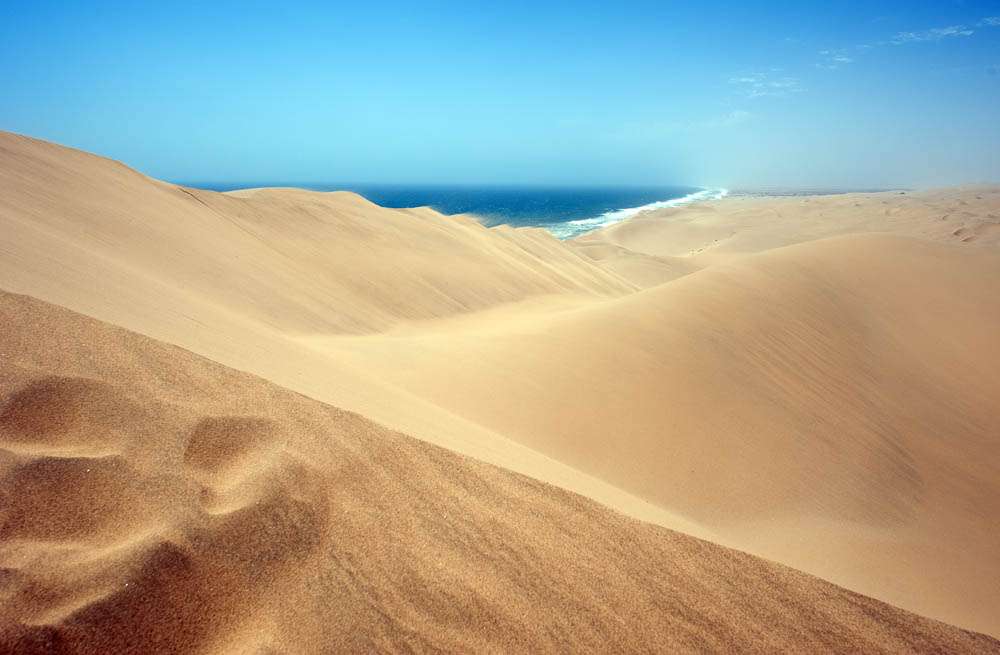
Sossusvlei Desert Lodge: Sossusvlei Desert Lodge, situated in the northern foothills of the NamibRand Nature Reserve, is designed to make the most of its breathtaking surroundings whilst providing a sophisticated and luxurious stay. The lodge consists of glass and stone curves, where walls and windows fold away completely to open out to the grassy plains, distant dunes, and mountain ranges. Each spacious, air-conditioned suite features a shaded deck, split level bedroom and living room with fireplace for cool evenings, en-suite glass encased bathroom and outdoor shower. Star gazing is a highlight with a star-viewing sky light in each room and an observatory with a powerful telescope. Guided activities on offer to explore the local reserve include scenic 4×4 nature drives, fascinating walks and exhilarating quad-biking excursions.
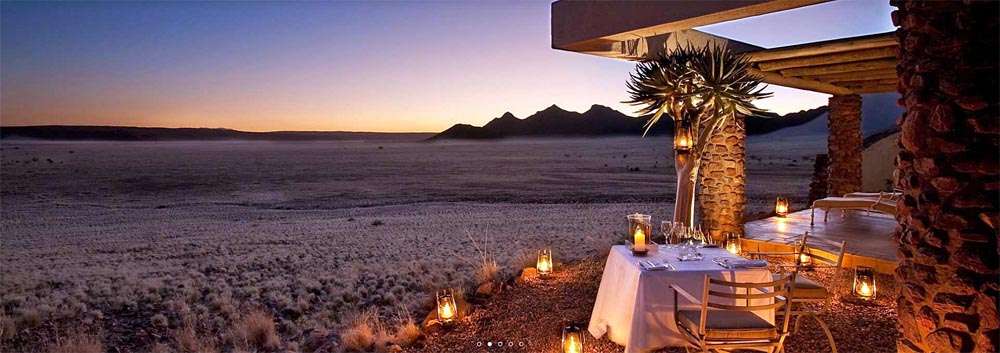
Overnight: Sossusvlei Desert Lodge Fully Inclusive (all meals, scheduled lodge activities & local beverages)
________________________________________
Day 13 Sossusvlei / NamibRand Nature Reserve
This morning you will rise early for a magical excursion with your lodge guide into the Namib Naukluft National Park, entering the Park gates at sunrise to capture the dunes whilst the light is soft and shadows accentuate their towering shapes and curves. This area boasts some of the highest free-standing sand dunes in the world. Your guide will give you an insight on the formation of the Namib Desert and its myriad of fascinating creatures and plants that have adapted to survive these harsh environs. Once you have explored the dune fields to your heart’s content you can enjoy a relaxed picnic breakfast in the shade of a camel thorn tree.
Return to Sossusvlei Desert Lodge in the early afternoon for a late lunch, stopping off to view Sesriem Canyon along the way. The rest of the afternoon is at leisure (from experience, this is usually welcomed after an exhilarating morning in the dunes) or can be spent on another guided activity within the NamibRand Nature Reserve as offered by the lodge.
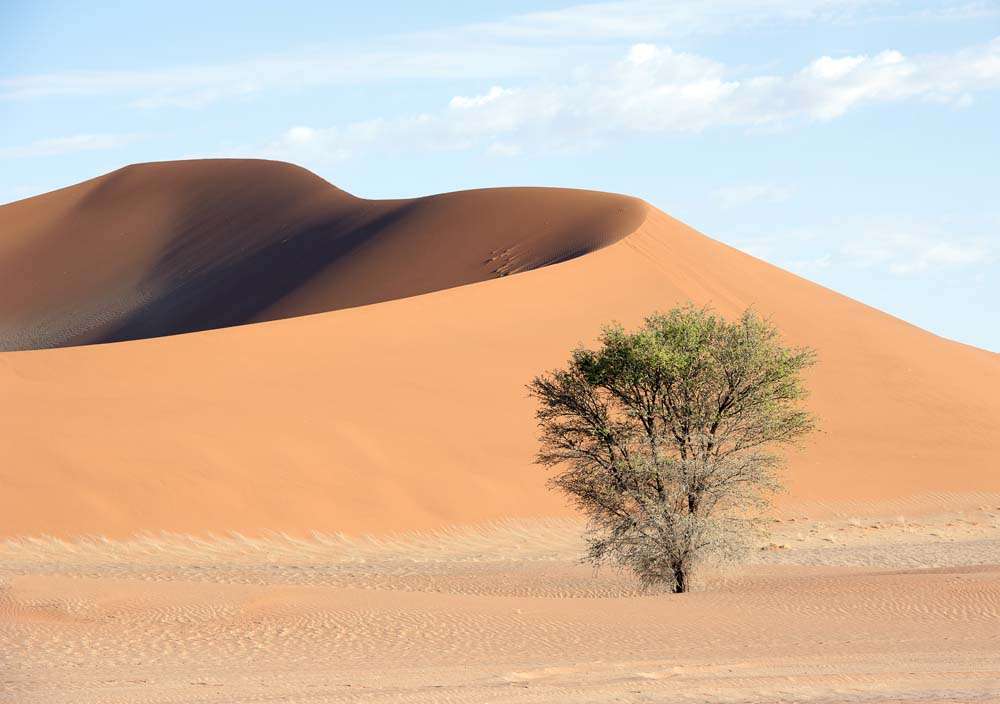
Sossusvlei: This most frequently visited section of the massive 50,000km² Namib Naukluft National Park has become known as Sossusvlei, famous for its towering apricot coloured sand dunes which can be reached by following the Tsauchab River valley. Sossusvlei itself is actually a clay pan set amidst these star shaped dunes which stand up to 300m above the surrounding plains, ranking them among the tallest dunes on earth. The deathly white clay pan contrasts against the orange sands and forms the endpoint of the ephemeral Tsauchab River, within the interior of the Great Sand Sea.
The river course rises south of the Naukluft Mountains in the Great Escarpment. It penetrates the sand sea for some 55km before it finally peters out at Sossusvlei, about the same distance from the Atlantic Ocean. Until the encroaching dunes blocked its course around 60,000 years ago, the Tsauchab River once reached the sea; as ephemeral rivers still do in the northern half of the Namib. Sand-locked pans to the west show where the river previously flowed to before dunes shifted its endpoint to where it currently gathers at Sossusvlei.
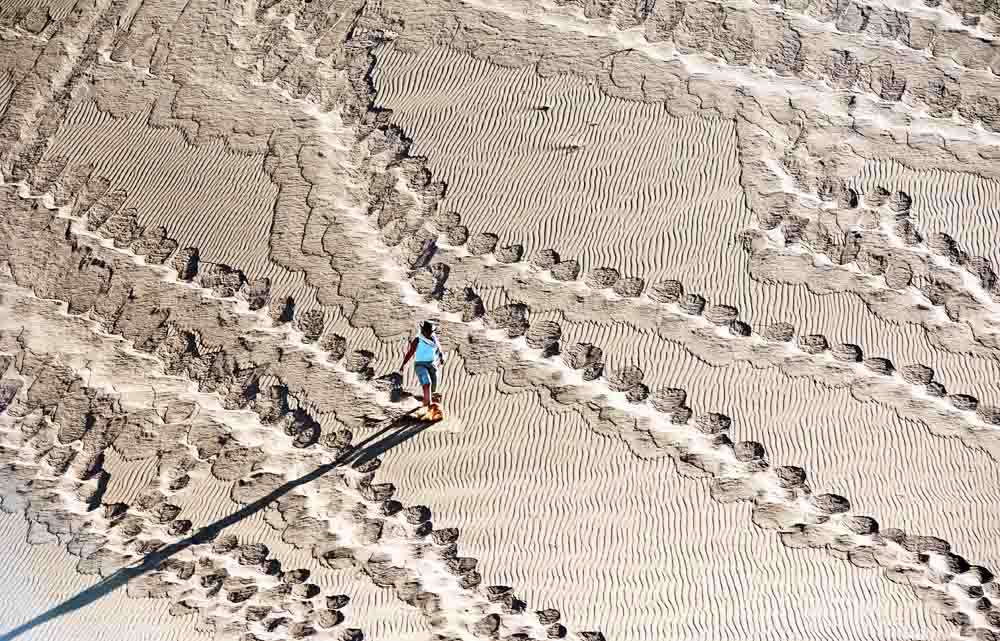
Roughly once a decade rainfall over the catchment area is sufficient to bring the river down in flood and fill the pan. On such occasions the mirror images of dunes and camel thorn trees around the pan are reflected in the water. Sossusvlei is the biggest of four pans in the vicinity. Another, famous for its gnarled and ghostly camel thorn trees, is Deadvlei which can be reached on foot over 1km of sand. Deadvlei’s striking camel thorn trees; dead for want of water, still stand erect as they once grew. They survived until about 900 years ago when the sand sea finally blocked the river from occasionally flooding the pan.
Sesriem Canyon: Sesriem Canyon has evolved through centuries of erosion by the Tsauchab River which has incised a narrow gorge about 1.5km long and 30m deep into the surrounding conglomerates, exposing the varying layers of sedimentation deposited over millions of years. The shaded cool depths of the canyon allow pools of water to gather during the rainy season and remain for much of the year round. These pools were a vital source of water for early settlers who drew water for their livestock by knotting six (ses) lengths of rawhide thongs (riems) together, hence the canyon and surrounding area became known as Sesriem.
Overnight: Sossusvlei Desert Lodge Fully Inclusive (all meals, scheduled lodge activities & local beverages)
________________________________________
Day 14 NamibRand Nature Reserve to Windhoek International Airport
Today you will be transferred back to the lodge airstrip for your schedule light aircraft flight to Windhoek’s International Hosea Kutako Airport. On arrival at the airport you will be met by a TLC World representative who will assisted you with your check-in and onward flight arrangements.
We wish you safe travels onwards and hope that your Namibian safari has been full of unforgettable highlights and memorable experiences!
Breakfast
________________________________________
N.B. We have prepared this itinerary on a top notch luxury basis and it is a guide only. You can add time and places to this and upgrade, reduce, or change travel and accommodation with us to make this a truly personal journey to suit your budget simply by clicking ‘enquire’, or phoning us on 01202 030443.
 14 DAY LUXURY GUIDED & FLY-IN NAMIBIA SAFARI FOR 2 PERSONS
14 DAY LUXURY GUIDED & FLY-IN NAMIBIA SAFARI FOR 2 PERSONS
Price guide per head:
From £6,900 per person
Based on two people sharing accommodation; excluding international flights
With a percentage of the cost of this itinerary going to The Cheetah Conservation Fund to help continue their work*
Why travel with a TLC World naturalist guide?
A TLC World naturalist guide will quickly turn a normal safari into a life enriching journey, creating a deeper understanding and appreciation for the incredible places and people that we visit. The guides are the link between our guests and the intricacies of the natural world, sharing their knowledge with enthusiasm and humor. Guests are taken on a journey through some of the world’s most beautiful wild places, encountering wildlife spectacles and engaging with age-old authentic cultures while receiving detailed interpretation as offered by our highly trained naturalist guides. Throughout this experience, they are wrapped in the warm and caring hospitality that makes us TLC World.
A guided safari offers our guests constant access to one or more of these exceptional guides who have an intimate knowledge of each camp/lodge and area we visit. This allows them to be able to expose the relevant highlights, adding continuity and depth to your safari, and effectively tailor-making your experience. It also means that they are able to take guests to stay at less sophisticated rural venues which might not otherwise be suitable for discerning visitors. The presence of our guide adds another level to the hospitality and service that can be offered there and thus ensures that we have the widest reach of options available to us while still maintaining the standards to which we aspire.
Our guides share in a philosophy that ensures they never cease adding to their encyclopedic knowledge and this makes them lifelong scholars in the fields of their expertise. Their infectious enthusiasm, dedication, character, and in-depth knowledge of the country ensure that guests are at the forefront of real, unique and authentic experiences throughout their journey. Being native to Namibia, our guides are welcomed as friends or family everywhere they go, thus ensuring authentic and life enriching journeys. These often result in guests becoming personal friends of both our guides and the people that they visit.
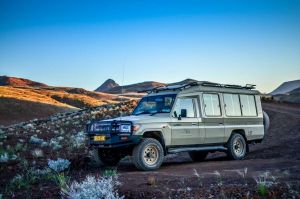 All our Land Cruisers are equipped with:
All our Land Cruisers are equipped with:
• Roof pop Tops for better photography and game viewing vantage points
• Air Conditioning
• Onboard Fridge/freezers and plenty of water.
• Personal library, which includes a series of guide books, maps, stationary and checklists.
• 220 volt electrical charging point, to charge electrical devices whilst traveling.
• Guaranteed window seat on every safari.
• VHF inter-vehicle radios that allow multi vehicle groups to communicate with each other while ‘on the road’
Our guides also travel with their renowned ‘MAGIC BOXES’, which ensure all en-route catering needs are taken care of, from a bush breakfast and coffee and tea stops to majestic sundowners.
*Donation: TLC World will donate 5% to the charity of the cost of all ground arrangements that include a visit to CCF, to help continue its valuable work.

 Fancy a similar adventure? If you’d like to plan your own
Fancy a similar adventure? If you’d like to plan your own
personal itinerary then simply phone 01202 030443 or click ‘enquire’


















